
Following the ceremony that signaled the start of “America’s Superhighway” in the late 1930s, Turnpike Commission Chairman Walter A. Jones and his crew were approached by a woman asking for their autographs. Puzzled by the sudden celebrity treatment, Jones asked the reason behind her request. The woman replied, “…so that my children can say that they saw history being made that day when the greatest highway, a new era of road building, was started.” Those words were spoken by a farmer’s wife whose land was bought to build one of the biggest expansion projects ever to connect roads across the state, the Pennsylvania Turnpike. The woman’s words reflected the hopes and dreams of many Americans who had been eager to see the completion of the freeway.
Although the Pennsylvania Turnpike is not the oldest or longest road system today, the PA Turnpike has left a distinguished mark in history as the conceptual blueprint for modern-day interstate highways. This roadway incorporated technologies that had never been used before and implemented many concepts still kept in mind today. After the completion of the PA Turnpike’s first section, the new highway system altered the way Americans traveled forever.
However, before the construction of the turnpike was even a concept, Pennsylvania tried many different transportation methods to cross the state. The biggest obstacle between the eastern and western parts of Pennsylvania was, and remains, the Appalachian Mountains. This massive barrier made it nearly impossible to cross back and forth efficiently. The first attempt at bridging this gap was a canal system that took travelers days to cross the state, but this venture soon became obsolete with new transportation innovations. During the 19th century, the next major mode of transportation to take PA by storm was to travel by train for long distances. Engineering innovations like Altoona’s Horseshoe Curve allowed trains to ascend the mountains that bisect the state. However, the invention of the automobile at the start of the 20th century created an alternative, and more personal, option for travelers. Most people chose to take the train because it would have been a long journey spanning several days to cross the state if traveling by car. In addition, inclement weather made the roads treacherous to drive, making the trip even more difficult.
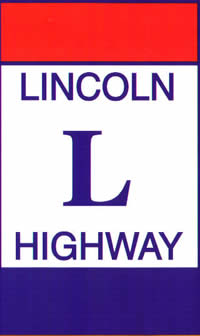
The Lincoln Highway of 1915 that stretched between Philadelphia and Pittsburgh had been the first attempt of creating a major road system. However, this highway was very winding and followed the same sharp curves that the Conestoga wagons used to maneuver in the 1800s. Even though the Lincoln Highway attempted a toll system, the profits plummeted and the roads deteriorated into dusty abandoned strips of cracked concrete. Repairs were made when interest in the road and driving became more popular and eventually the Lincoln Highway spread across the United States spanning over 14 states and reaching a mileage record of 3389 miles. Today the Lincoln Highway is still designated, following much of US Route 30 in the southern part of the state. Even though this highway was the first and longest road system, it was not until the PA Turnpike came online that drivers began to see technological advancements implemented to create an easier and safer road system to travel; the PA Turnpike avoided both the cross traffic and the steep grades that the Lincoln Highway faced.
Despite the beginning attempts of road systems like the Lincoln Highway, most transportation across the state was still conducted by the railroads. Two companies controlled the railroad industry on the eastern side of the United States during the 19th century. One was the New York Central & Hudson River Railroad Company (NYC&HR), and the other was the Pennsylvania Railroad Company (Pennsy). During this time period competition within the railroad industry was fierce, and there were several strategies the companies employed to gain a competitive edge. It became common practice to build new tracks, expand railroad tracks, or buy the stock of newcomers to force the competition out of business. These tactics would later provide significant routing for the creation of the PA Turnpike.
At the time, William H. Vanderbilt, the owner of the NYC&HR, felt his company’s main competitor was intruding upon his territory near the Hudson River. In order to gain the upper hand, Vanderbilt decided to construct the South Pennsylvania Railroad. The new railroad was to run directly parallel with the Pennsy’s main line to create competition and prevent a monopoly in that part of PA. A lot of people were excited by this project because they felt the Pennsylvania Railroad’s freight rate was too expensive and the additional competition would prove to be beneficial for all. The project was backed by steel magnate Andrew Carnegie since he too was angered by the outrageous rates the Pennsy was charging for transportation.
However, this project was abandoned in 1885 when J. Pierpont Morgan, a board member of NYC&HR and a powerful financial banker, convinced both railroad companies to come to a truce. Morgan felt that the completion of the South Pennsylvania Railroad would potentially hurt the company’s profits. Upon hearing the news, workers of the South Pennsylvania Railroad simply stopped working and walked away from the work site. This aborted venture of Vanderbilt has become known as “Vanderbilt’s Folly.” The semi-constructed railroad lay unused for over 30 years, until William Sutherland of the Pennsylvania Motor Truck Association and Victor Lecoq of the State Planning Commission decided the PA Turnpike was to be built in the 1930s from Vanderbilt’s abandoned railroad project.
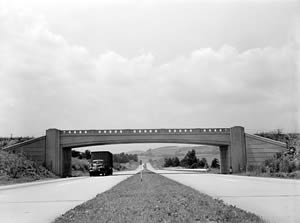
When the Great Depression hit the economy, almost everyone suffered from the financial crisis. Even though only a few people were able to afford new automobiles, the popularity of cars still remained high. Highways became in demand when the number of automobile owners reached a record high, and soon the state of New York constructed the first express highway in American history, the Bronx River Parkway.
The completion of the Bronx River Parkway drew the attention of many Pennsylvania State officials. Though the railroads had long since constructed routes to traverse the Appalachian Mountains, cars, trucks, and motor bikes still had great difficulty doing so. This repeated complaint of the people prompted William Sutherland and Victor Lecoq to join forces and propose the idea of the Pennsylvania Turnpike in 1934. Their plan involved using the abandoned South Pennsylvania Railroad tunnels and roadbeds. The men suggested their idea to a newly-appointed state legislator, Cliff S. Patterson, during a dinner conversation and the resolution was later passed by the state. The Pennsylvania Turnpike Commission was formed with the passage of Bill 211, and Walter A. Jones of Pittsburgh was appointed commission chairman.
Although the bill was able to pass with little trouble, funding for construction of the highway proved to be more of a challenge. The legislators specified that no state funds would be used to finance the project. Many financial bankers were reluctant to participate in support of building a major highway given that the proposed total distance was 160 miles from Carlisle (near Harrisburg) to Irwin (near Pittsburgh), and a road of this magnitude had never been dreamed of before. Therefore, investing money into something so uncertain seemed to be a risky venture. However, all hope for the PA Turnpike was not lost because Commissioner Jones used his political position to interest President Franklin D. Roosevelt into funding the project. President Roosevelt backed the project because he hoped it would help decrease unemployment. He was able to fold the construction of the highway into his New Deal policy. The government was able to provide loans to finance the cost of building the PA Turnpike. The construction of the Pennsylvania Turnpike finally commenced on October 27, 1938—a day that marks the beginning of the first superhighway.
The new highway system was constructed along the original path of the aborted South Pennsylvania Railroad project of the 1880s. Six of the seven tunnels from the SPR’s attempt were utilized for the PA Turnpike. The seven tunnels included Allegheny Mountain, Blue Mountain, Kittatinny Mountain, Laurel Hill, Rays Hill, Sideling Hill, and Tuscarora Mountain. The first 160-mile road section from Carlisle to Irwin was completed in 1940. Engineers had outlined certain features that would improve traveling conditions for drivers and make traveling safer. These attributes included limited access with a 1,200-foot-long distance and exit ramp for safe accelerating and decelerating area, substantial super-elevation on the curves, and a four-lane divided configuration. Most importantly, security and comfort of the drivers were among the top priorities in the engineers’ minds when choosing the design for the turnpike.
“Unlike the existing highway systems of the United States, in which design standards fluctuate every few miles, depending on the date of construction, the turnpike will have the same design characteristics throughout its 160-mile length,” said design engineer Charles Noble in a July 1940 issue of Civil Engineering. “Every effort has been directed towards securing uniform and consistent operating conditions for the motorist.”
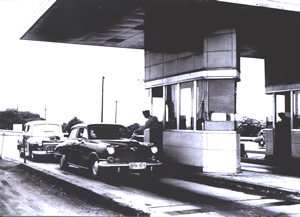
Moreover, the new highway was to include toll booth and service plazas. It is important to note that the first engineered turnpike in the United States was the 62-mile privately constructed toll road, the Philadelphia and Lancaster Turnpike, built between 1793 and 1795 to connect Philadelphia to Lancaster, but was later replaced by a canal in the 1800s. Turnpikes get their name because after a traveler paid a toll, the toll booth worker had to turn a pike in order to let them through the interchange. Revenue made by the PA Turnpike toll booths was surprising given that critics estimated under 800 cars would pass through a day after its opening. However, it was recorded by the turnpike officials that within the first four days of operation there had been 240,000 vehicles driving the new highway. By calculating the number of tolls paid, the turnpike made $140,000 in revenue. Tolls were necessary to fund other state projects, to maintain the roads in proper traveling conditions, and also for further expansions of the turnpike. Profits generated by the Pennsylvania Turnpike had altered the standards for future national highways and they would keep the concept that “interregional highways contained Toll Roads and Free Roads.” Today’s 43,000-miles of interstate highway systems used the PA Turnpike as a blueprint due to its many innovated improvements to road construction and success of numerous travelers.
People came in droves from all over to be the first to travel the Pennsylvania Turnpike on its opening day. The Harrisburg Telegraph described the event to be like the beginning of a car race: “At midnight, two black cats ambled across the gleaming cement. A minute later, a ticket-seller dropped his arm in the gesture of an automobile race-starter, and traffic was under way.” The first traveler to pass through the Carlisle toll booth was Homer D. Romberger, a native Carlisle feed and tallow dealer, and Carl A. Boe of McKeesport was the first at the Irwin interchange. It’s interesting to note the first two hitchhikers on the PA Turnpike, Frank Lorey and Dick Gangle, were picked up by Boe shortly after he had gone through the turnstile. There were many other firsts on opening day and everyone wanted their chance of fame.
Unlike today, there was no established speed limit when the turnpike opened and motorists excitedly recounted their tales to others of traveling the highway at speeds up to 80 or 90 MPH. One Ohio trucker who feared getting a speeding ticket remembers his first run-in with the police on the PA Turnpike: “I was going down one of those grades at 70 to 80 miles an hour. I looked in the mirror and saw a white car following me. I didn’t know whether I was going to get arrested, so I pulled off the road as though to take a rest. The white car pulled off, too. An officer got out and asked me, ‘How do you like the road?’ I said, ‘It’s very nice - I guess I get a ticket.’ The cop told me, ‘No, we aren’t interested in the speed limit. As long as you stay on your own side and watch yourself, we won’t bother you.’” However, speeding did begin to pose a problem and a 50 MPH speed limit was imposed.
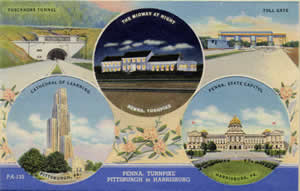
Towns situated along the new highway were concerned that the turnpike would turn them into “ghost towns.” Though this may have happened for a select few, the turnpike did increase traffic and profits for the towns located near the interchanges. Towns including Breezewood, Bedford, and Somerset boomed after the opening of the Pennsylvania Turnpike. Even with some negative consequences for a few towns, the turnpike proved to be a much needed and economic-stimulating project for Pennsylvania in the 1930s.
Talks of expanding the 160-mile highway had to be put on hold until after World War II. The Pennsylvania Turnpike Commission decided in 1950 to add the Philadelphia Extension to the PA Turnpike to connect Carlisle all the way east to Valley Forge. A year later the Western Extension was added connecting Pittsburgh to the Pennsylvania/Ohio border. In 1954, the Delaware River Extension bridged the gap from Valley Forge to the New Jersey Turnpike. In addition, the 110-mile Northeast Extension expanded north in 1955 from the Philadelphia/Valley Forge area to slightly above Allentown. Then two years later it was expanded past Scranton to Clarks Summit.
The Northeast Extension has become a heavily traveled road since the Pocono area has been a very popular vacation destination. By the 1980’s, 22,000 vehicles per day were going through the Lehigh Tunnel, creating traffic jams and a massive strain on the tunnel. To alleviate this problem, the Pennsylvania General Assembly passed Act 61 to allow the construction of a parallel Lehigh tunnel for southbound traffic. The tunnel project was the first in the United States to use the “New Austrian Tunnel Method.” It had originated in Europe during the 1950s and was used to build subway systems in Washington and Pittsburgh. Unlike traditional tunnel constructing, which required steel beams to hold up the infrastructure, the “New Austrian Tunnel Method” utilized a feeder gun to shoot liquid concrete (also known as “shotcrete”) instead to keep the sides and ceiling of the tunnel stable. This second tunnel was financed through toll hikes and opened for business on November 22, 1991. Both the northbound and southbound tunnels were fully operational by 1992 and the Northeast Extension remains a common road used to travel to the Poconos.
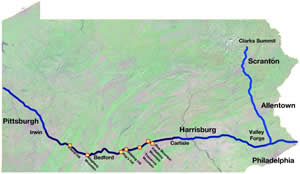
Today the PA Turnpike covers 530.5 miles with 359 miles from the Delaware River to Ohio, 110 miles for the Northeast Extension, and 61.5 miles for the Western Extensions, according to the Pennsylvania Turnpike Commission Web site. Currently there are 57 toll booths and 18 service plazas scattered throughout this huge highway system. According to the last PTC figures, 188 million vehicles traveled the PA Turnpike in 2005, compared to 2.4 million cars during its first full year of operation.
Wishes to expand the turnpike again have been discussed since the 1980s, spilling over into the 21st century. The most recurrent and controversial ideas has been to toll I-80 across the northern third of the state. However, neither this idea nor any others have been confirmed or initiated at the present time.
The planners of the Pennsylvania Turnpike did not originally intend to revolutionize transportation in the United States. Initially, the plan was to create a mode of convenient transportation for motor bikers and truckers, yet they ended up creating a turnpike that benefited both the economy and transportation. Building the turnpike helped to stimulate Pennsylvania’s economy by hiring thousands of workers from local areas of Pennsylvania to complete the grand project. Convenience of travel was immensely improved after the building of the Pennsylvania Turnpike because the benefits of having a concrete road with spacious lanes, loosely-controlled speed, and less time spent traveling great distances made driving easier and more practical. All of these positive characteristics of the interstate highway we enjoy today are thanks to the pioneering design of the first segment of the Pennsylvania Turnpike. Truly, the Pennsylvania Turnpike has earned the nickname Mitchell Dakelman used in The Pennsylvania Turnpike: Images of America: as the “World’s Greatest Highway.”
Sources:
- Cupper, Dan. The Pennsylvania Turnpike: A History. Lebanon, PA: Applied Art Publishers, 2001.
- Dakelman, Mitchell E., and Neal A. Schorr. The Pennsylvania Turnpike: Images of America. Charleston, SC: Arcadia Publishing, 2004.
- Hokanson, Drake. The Lincoln Highway: Main Street Across America. Iowa City: University of Iowa Press, 1999.
- Longfellow, Rickie. “The Abandoned Pennsylvania Turnpike -Back in Time - Highway History - FHWA.” Federal Highway Administration: Home. 30 Mar. 2009 <http://www.fhwa.dot.gov/infrastructure/back1007.cfm>.
- Miller, A. M.. Engineering News-Records: A Weekly Journal of Civil Engineering and Construction Practice (Volume 122) January to June, 1939. New York: McGraw-Hill, 1939. 31-32.
- “NJTA- About the Turnpike.” The Official Web Site for The State of New Jersey. Web. 23 Sept. 2009. <http://www.state.nj.us/turnpike/nj-about.htm>.
- “Ohio Turnpike Commission - History.” Ohio Turnpike Commission. Web. 23 Sept. 2009. <http://www.ohioturnpike.org/about/history/>.
- “Pennsylvania Turnpike.” Pennsylvania Highways. Web. 21 Sept. 2009. <http://www.pahighways.com/toll/PATurnpike.html>.
- “Pennsylvania Turnpike-Northeast Extension (I-476).” Philadelphia Area Roads, Crossings and Exits. Web. 14 Sept. 2009. <http://www.phillyroads.com/roads/pa-turnpike_delaware-river/>.
- “The Abandoned Pennsylvania Turnpike Brief History.” Brian Troutman - briantroutman.com. 16 Sept. 2009. <http://www.briantroutman.com/highways/abandonedpaturnpike/>.
- “The Pennsylvania Turnpike - About the PTC.” The Pennsylvania Turnpike. 1 Mar. 2009 <http://www.paturnpike.com/geninfo/history/history.aspx>.
- “Turnpike Facts, information, pictures | Encyclopedia.com articles about turnpike.” Encyclopedia - Online Dictionary | Encyclopedia.com: Get facts, articles, pictures, video. <http://www.encyclopedia.com/topic/turnpike.aspx>.
